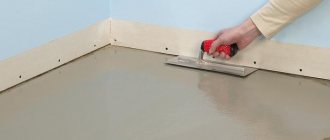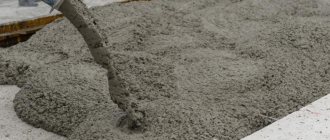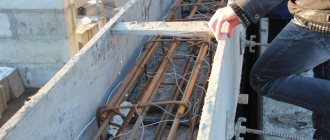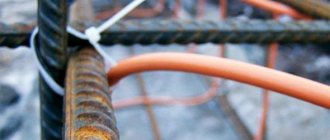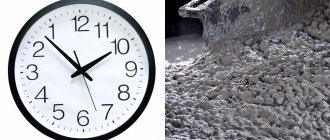The drying time of concrete (or, to be precise, the time it takes to gain strength) is precisely the factor that significantly slows down any construction. And the main difficulty in this case is the fact that reducing this time can only be achieved by carrying out rather complex and costly activities.
Below we will describe what happens to the solution when it dries, and also provide a number of recommendations for optimizing this process.
Adjusting the moisture content of the material is an important factor in ensuring its performance
How long does it take for cement to dry and how to speed up this process?
The process of drying cement, or more precisely concrete or a mortar based on it, is a complex process that requires compliance with certain conditions. Knowing after what period of time you can begin to load or operate the structure, you will protect your home or structure from cracking or destruction.
What affects the drying speed of cement?
What determines the drying speed?
During the drying process, it goes through several stages of “curing”: setting, strengthening and complete drying. At the same time, the time frame for each stage is strictly individual and depends on the following factors:
- Ambient temperatures;
- Relative air humidity;
- Cement grades;
- Type of cement;
- The absence or presence of special additives in cement or concrete.
The main factor in the speed of the hardening process is the ambient (air) temperature. The average calculated average daily air temperature at which the concrete polymerization process proceeds “correctly” is considered to be a temperature of 20 degrees Celsius with air humidity tending to 100%.
When the temperature rises, the hardening process accelerates, and when it decreases, it slows down. You should know that when the ambient temperature drops to 0 degrees and below, the cement hardening processes practically stop and in order to resume them, it is necessary to heat the concrete in any of the following ways:
- Heathouses (tents) built over a flooded structure and any heat sources;
- Special heating mats;
- A heating wire laid during pouring and a special transformer or welding transformer.
Theoretical part of the question
If you study the hardening of a concrete mixture from a scientific point of view, then there are two stages of this process:
- grasping;
- hardening.
Upon completion of the first stage, the composition loses its mobility, which is necessary for uniform distribution of the mixture in the formwork and high-quality performance of work. During the setting , you need to have time to complete the following processes:
- transportation to the construction site when using factory-made concrete (to extend the setting time, the composition is transported in concrete mixers, thanks to mixing in which the life of the solution increases);
- pouring into formwork;
- compaction and leveling.
Hardening is the crystallization of the solution, increasing its strength and rigidity. Hardening takes longer than setting. The duration of both processes largely depends on:
- ambient temperature;
- type of binder for mixing concrete;
- water-cement ratio.
Concrete is an artificial stone, which is characterized by the properties declared by the manufacturer only after reaching full brand strength. During the solidification process, strong bonds are formed between individual particles of the substance, and it is extremely important whether the technology was followed.
How long does it take for cement to dry in comfortable conditions?
You will find the answer to this question in the following table, which is valid for most popular brands of cements, concretes and cement mortars.
| Period, day | Design strength of concrete, % |
| 3 | 30 |
| 14 | 60-80 |
| 28 | 100 |
It is worth noting that the design strength of concrete is not synonymous with the “drying” of concrete. This value indicates that the poured structure is ready for use or further loading by walls, ceilings, roofs, etc. Complete drying of concrete occurs over the course of one year or several years, depending on the “massiveness” of the concrete: foundation, columns, walls, beams, slabs, platforms, floors, etc.
Drying plastered walls.
Plastering is an important part of all construction work. It is used as a protective and strengthening basis for other finishing works. Plaster helps to increase the strength of the structure and thicken the wall.
But if you apply the finishing touch to wet material, it will lead to negative results. After a certain period of time, the cladding layer may fall off or crack. To prevent cracks from occurring, it is necessary to consider how long the plaster takes to dry. This factor depends on many circumstances: the thickness of the mixture, the type of solution or climatic conditions.
To ensure better adhesion to the base, the following conditions must be met:
- Protection from exposure to sunlight.
- Eliminate excess moisture through ventilation.
- Refusal of various drying devices. In this case, the material dries for the required amount of time.
How long the plaster takes to dry also depends on the composition of the solution.
Cement plaster.
Plastering walls with cement is popular due to its ease of use and high quality of the material. Cement is made from crushed gypsum base and clinker, which is obtained by firing a mixture of special clay and limestone. Various additives in the composition help improve adhesion, elasticity and load resistance. How long it takes plaster made from this material to dry depends on the thickness of the layer and the base. The cement mortar is characterized by high density and moisture resistance, so it dries within 28 days.
In order for the material to dry well, it must be applied correctly:
- The humidity level should not be more than 60%, and the temperature should vary from 5 to 20 degrees.
- The solution must be diluted strictly according to the instructions. This affects how long the plaster takes to dry.
- After completing the work, tools should be thoroughly cleaned.
- The next layer of coating is applied only after the first has dried.
It is easy to check the readiness of the surface: you need to press the coating with your finger, if the material is not pressed in or crumbles, then you can apply another layer. If the composition crumbles, it takes more time.
Gypsum plaster.
Gypsum plaster allows you to create a smooth surface without defects. It is considered a safe and environmentally friendly material that does not cause harm to the human body. This material helps create optimal humidity in the room after a certain period of time and create a comfortable microclimate. Gypsum mixture is popular due to its ability to create a high-quality thermal insulation layer, which allows you to save on heating costs. The advantage of the mixture is the possibility of applying layers of coating after a minimum period of time: from half an hour to two hours. How long it takes for gypsum plaster to dry completely depends on the thickness of the coating. The maximum period is five days. You can tell when the surface has completely dried by a change in color. The wall becomes lighter. In this case, all surfaces should change color. Only after this the finishing begins.
In order for drying to take place on time, it is necessary to follow certain recommendations when applying the solution:
- The gypsum mixture dries within a short period of time, so the solution is prepared in small portions.
- After hardening, the mixture is not used.
- For a thin layer, a liquid solution is made; for a layer with a thickness of 20 mm or more, the mixture should be thick. A thin layer takes less time to dry.
- The room in which plastering is performed must be dry, and the temperature should be 5-25 degrees.
Mortar.
Lime mixtures are characterized by high plasticity. In addition, they help prevent mold from growing on the walls. The surface after such plastering becomes strong and durable. The use of lime mortar for finishing has been known since ancient times. This finishing method is characterized by ease of execution and low cost.
The next layer of plaster can be applied after a seven-hour break. A similar mixture is used for lining furnace equipment, as it can withstand high temperatures. The surface dries for about five days. This time is enough for the coating to dry completely.
Using lime requires some knowledge:
- Water is added to the solution not by stream, but by means of a sprinkler.
- Before plastering, the surface is thoroughly cleaned.
- It should be taken into account that when slaked, lime increases in volume.
The readiness of a lime wall can be determined by the time elapsed and the degree of appearance of whiteness.
How is drying time determined?
Inexperienced craftsmen begin the final finishing without waiting for the plaster layer to completely dry. To avoid making such mistakes, you should know how long it takes for the plaster to dry. The following rules apply to determine drying time:
- A simple rule will help you calculate the time it takes for the finishing layer to dry. Within 6 hours, 0.1 cm of coating dries. This works at a minimum humidity level.
- The layer thickness varies from 1.6 cm to 6.5 cm. The average drying time is 4 days.
- If the room humidity is normal and all installation conditions are met, drying time will take less than a day.
- Finishing is carried out after the total surface moisture content becomes no more than 9%.
Ways to speed up the drying of concrete
At this point in time, there is only one effective way to accelerate the hardening of concrete under normal conditions (ambient temperature 20 degrees Celsius and humidity tending to 100%).
This is the use of special setting accelerator additives: potash (potassium carbonate K2CO3), calcium chloride, calcium nitrate, calcium nitrite-nitrate, calcium nitrite-nitrate-chloride, trisodium phosphate and a number of others. The introduction of special additives into concrete not only speeds up the process of gaining brand strength by an average of 80%, but also: increases the frost resistance of the structure (up to 300 freezing cycles), reduces water permeability, increases molding properties and reduces cement consumption.
Source
What factors influence hardening?
Among the main factors are:
- temperature conditions;
- brand of cement used;
- humidity level.
Hardening under unfavorable conditions can lead to cracks appearing under load. Source 1beton.info The higher the temperature outside or indoors, the faster the mixture gains its strength.
When the temperature drops below 0 degrees, the hydration process stops. Many builders consider the optimal temperature for pouring concrete to be between 18 and 22 degrees. The grade of concrete is designated by the letter M. The value of the grade can vary from 50 to 800. The higher the indicator, the stronger the concrete is considered and the less time it takes to harden. Even though higher grades cure faster, it is still recommended to cure them for at least 4 weeks before loading.
The level of environmental humidity directly affects the hydration process. At very low humidity, hardening slows down. At very high humidity it accelerates. Normal concrete strength gains occur at a humidity of about 80-100%.
What to do if the screed does not dry
There are several reasons for the slow drying of the screed:
- Violation of the temperature regime in the room. Optimal conditions: from 21 to 25 degrees C;
- Failure to maintain recommended humidity levels. Experts advise maintaining the standard 40-60%; if the indicator is exceeded, the period of complete drying increases;
- Short holding period. Average formula for calculating time: 1 cm – 7 days, if the total thickness is more than 4 cm, 1 cm – 10 days;
- Incorrect proportions of dry mixture and water when mixing. A solution that is too liquid is pliable and easier to work with. At the same time, the drying time increases by 10-20%.
In most cases, errors can be corrected, thereby reducing the overall drying time of the solution.
If the temperature and humidity conditions are not met, optimal conditions should be created:
- When air humidity is high, cover the base with film and ventilate with doors or windows closed, avoiding drafts.
- At low temperatures, you cannot turn on the heating or underfloor heating - sudden changes are contraindicated for the screed. It is permissible to heat only water when watering the base, but it is used only in the first week. It is permissible to slowly increase the temperature in the entire room, without exceeding the maximum of 25 degrees.
When the screed is too thick (8-12 cm) or the solution was initially too liquid, prolonged drying is inevitable. Excess moisture takes longer to leave the base.
It is prohibited to pour finishing compounds onto a wet screed. The new solution will not dry out and will not gain strength properties. It will not be possible to “reanimate” it - complete removal will be required.
Application of a concrete hardening and setting accelerator
Normal concrete hardening is a long and responsible operation. The final characteristics of the product, such as strength and durability, will depend on its flow. But in some cases it is not possible to wait the required 28 days or it is simply impractical. Then accelerators come into play, “accelerating” chemical processes, but not worsening the quality of the fill.
Features of concrete setting
The hardening process of the solution occurs with the participation of water. Optimal hydration conditions are considered to be an air temperature of about +20°C and a relative humidity of at least 90%. Moreover, the humidity regime must be constantly maintained, otherwise the hardening of concrete will stop. If there is a lack of water during the hardening period, the structure will lose its solidity and become fragile.
When you need to speed up this process:
1. When performing work in winter, reducing the air temperature to 0°C stops the hardening of the solution. In cold weather, moisture completely turns into ice. To ensure normal hardening of concrete, it has to be heated, and setting and hardening accelerators reduce the heating time, reducing energy costs.
2. If early stripping is necessary (when the turnaround time of the equipment is important).
3. To resume construction work before the 4-week hardening period for the mortar has expired.
4. When producing large volumes of piece reinforced concrete products. The use of accelerators in these cases allows you to make do with a smaller set of molds and produce batches of high-quality goods faster.
5. To optimize the plastic properties of the solution and the strength characteristics of concrete that has undergone hardening (by revising the water-cement ratio).
Varieties
| Chemical affiliation | Guest accelerators | |
| Name | Formula | |
| Carbon dioxide salts | Potash | K2CO3 |
| Sulfate salts | Sodium sulfate | Na2SO4 |
| Nitrates | Calcium and sodium nitrate | Ca(NO3)2, NaNO3 |
| Ammonium salts | Urea | CO(NH2)2 |
| Chlorides | Calcium | CaCl2 |
| Sodium | NaCl | |
How quickly does concrete mix dry?
The use of concrete in many construction processes is an incentive that forces craftsmen to study the characteristics and properties of this material. Without knowledge of the theory, it is impossible to determine the correct proportions of the solution, as well as the time required for the concrete structure to initially set or completely harden. Hardening time is an important indicator for a specialist, since on their basis it is possible to draw up a schedule for further work.
The hardening of a concrete solution is a rather complex chemical reaction. It is called hydration, and its essence is that the original composition in the presence of water molecules is converted into calcium hydrate. The binder component is mineralized, thereby binding the mixture into a monolith.
Concrete poured into formwork goes through two main stages:
The first stage does not last long. It begins shortly after mixing (approximately 2 hours). The setting time of concrete of the most popular grades M 200 and M 300 in private construction at 20°C is 60 minutes. If the air temperature outside is low, but not below zero, then the mixture will begin to set in about 5 hours, and if it is high, then very quickly - in just 15-20 minutes.
Concrete at a temperature of 0 degrees begins to set only after 6-10 hours. This “delay” is due to the weak progress of chemical processes. The setting itself lasts from 15 to 20 hours. At subzero temperatures, the reaction of water and cement stops, which causes irreparable damage to the structure. The mixture does not actually dry, but remains in an inert state until the outside temperature rises to 0°C or higher.
Modern supplements solve the problem of hydration in cold conditions. At the mixing stage, special components are introduced into the solution to stimulate hydration and the occurrence of chemical processes, as well as prevent water crystallization. The product label always indicates the proportions so that the specialist can accurately calculate how much additive is needed at a certain temperature.
The second way to continue hardening at sub-zero temperatures outside is warm formwork. It provides normal conditions for hardening of the mixture, but does not accelerate natural hardening.
If poured concrete outside needs special care during the cold season, then using warm formwork in the summer to speed up hydration is tantamount to deliberate damage to the pour. Hardening will take place 2 times faster, but the solution will be dehydrated, the hydration process will stop, and the structure will not achieve the required quality and strength.
After the first stage, the second begins - hardening. During this stage, the concrete in the formwork dries and gains strength. The control period for hardening is 28 days (at a temperature of 20-22 °C and a humidity of 68%). But it takes months and even years for a concrete structure to reach its maximum strength characteristics.
Construction formulas and existing charts allow you to quickly and accurately determine the percentage of strength. You can calculate the Rn index for concrete whose age is n days (n≥3) using the formula:
Rn = R28(lgn/lg28), where:
- R28 - brand (for example, M 200 or M 300);
- n is the number of days that have passed since the mixture was poured into the formwork.
How long does it take for concrete to set?
The setting stage of the solution lasts a short time. On average, for the most popular brands (M200, M300) it does not exceed 1 hour at a temperature of +20°C. If the temperature is lower, the time increases to 4–5 hours, and in hot weather, coupling may take no more than 20–30 minutes.
Builders need to take into account the hardening time of concrete, since the finished solution very quickly loses its plasticity. To avoid possible problems in the future, use the prepared mixture immediately after mixing. Often it is delivered to the construction site ready-made in special concrete mixers, which do not stop mixing even during transportation.
How to influence drying speed?
There are situations when it is necessary to change the hardening time of the concrete mixture. In such cases, various techniques are used.
1. Industrial production.
Precast concrete factories accelerate the hardening of the solution by increasing temperature and pressure. Heating is bad for hydration because it dries the concrete very quickly. But intense evaporation is compensated by autoclaving or steaming. Precast concrete products can be used on a construction site literally within a day.
2. Private construction.
Industrial methods are absolutely unsuitable for an individual developer. It is possible to increase the temperature by heating the room or the mixture in the formwork, but the owners risk getting a floor, foundation, or blind area with cracks and peeling sand.
At home, you can cover the concrete with plastic film or coat it with bitumen mastic to reduce evaporation. It is necessary to intensively wet the surface with water (spraying, spraying). Such methods will prevent dehydration and increase hydration, although they will not speed up hardening in any way.
In the cold season, private developers need to use warm formwork or warm up the concrete structure with electrical wires. Anti-frost additives are also used (introduced into the concrete composition).
There is a method of “delayed hydration”. Its essence is as follows:
- antifreeze substances are added to the solution;
- pouring is carried out at -15°C and below;
- water freezes, hydration stops;
- In the spring, the structure defrosts and the natural hardening of concrete begins.
The disadvantage of the technique is a decrease in the quality of the design.
Caring for concrete after pouring
Caring for concrete has the goal of creating such hardening conditions, under which concrete will gain a given strength at the required speed, and its structure will be of the highest quality.
Providing the correct temperature and high humidity is critical to optimize the curing process.
After laying the concrete mixture and compacting it (if any), special measures are taken to care for the concrete.
Protection against moisture evaporation
Hardening of concrete looks like drying, but in fact, it is a reaction that occurs with the obligatory participation of water. When concrete hardens in air, its surface dries quickly and the hydration reaction stops. A pressure difference is formed in the thickness of the concrete and on its surface, which leads to the appearance of defects in the form of cracks.
To protect against drying out, the concrete surface is covered with waterproof materials, such as film, tarpaulin, and in some cases, a layer of sawdust or sand, which is constantly wetted.
Ensuring uniform temperature
When pouring massive structures (for example, foundation slabs), another problem arises - the temperature gradient.
Hydration reactions occur with the release of heat. In massive structures, there is a difference between the temperatures in the thickness of the concrete and on its surface. In the thickness of the concrete layer, the temperature can reach 50–80°C. If the difference with the surface temperature exceeds 20–30°C, the concrete structure may rupture, which leads to intense cracking on the outside of the structure and loss of strength.
To prevent a temperature gradient, it is necessary to reduce the temperature of the entire structure. To do this, after covering with a steam- or waterproof material, cold water is poured onto the surface of the concrete, changing it after heating.
The temperature drop should not be sudden. It is allowed to reduce it by 1–2°C per hour, and for some types of structures by no more than 12–13°C per day (this information is indicated in the regulations).
To carry out these activities, it is necessary to know the exact temperature in the thickness of the concrete; According to the regulations, it must be measured every 1–2 hours on the first day, and then once every 8 hours and the data obtained must be recorded in special journals. In order to be able to measure the temperature, when pouring the concrete, tubes are inserted at a distance of no more than 8 m from each other.
Cooling protection
In winter, the task arises of retaining heat in concrete, since at temperatures below plus 5 ° C hardening stops. The main task is to ensure hardening until the concrete acquires critical strength.
Critical strength is called the strength in winter, upon reaching which the freezing of water in the pores of concrete is no longer destructive (usually 30-50% of the design strength).
Various methods of heat preservation are used:
Warming up with electrodes or infrared radiation (the latter is technologically difficult).
Installation of greenhouses with heated air.
The use of the retained heat of the hydration reaction (“thermal osmosis” or “thermos method”), for which the surface of the concrete is covered with thermal insulation materials, such as mineral wool slabs, rolled materials in several layers.
Antifreeze additives. If calcium chloride was previously used, now its use, like other chlorides, is not recommended due to its aggressive effect on the reinforcement. More often they use calcium or sodium formate and other electrolyte salts that reduce the freezing point of water or ready-made complex additives that have not only an antifreeze, but also a plasticizing effect.
The use of accelerator additives in conjunction with heat treatment. In this case, additives are needed to quickly achieve critical strength, then, with the help of warming or heat-preserving measures, the optimal temperature is ensured until the design strength of the concrete is achieved.
Drying concrete correctly
Main stages
Until the solution has set, it can be leveled
To understand how to dry concrete as quickly as possible and without loss of quality, you need to understand what happens inside the solution itself after pouring. If you do not take into account the chemical component (it is of interest only to professionals), then several stages can be roughly distinguished. For ease of analysis, we have compiled them into a single table:
| Stage | What's happening? |
| Grasping | As soon as we poured the solution into the formwork or mold (if we were not quick enough, then in the trough or container of the concrete mixer), the cement begins to react with water. In this case, primary hydration of the most active components occurs, and polymerization of part of the material occurs. As a rule, this process takes from 30 minutes to several hours. During this time, concrete remains fluid and can be processed quite simply. |
| Strengthening to design value | After primary hardening, the rate of cement hydration decreases markedly, but still remains at an acceptable level. During this time, the poured concrete hardens, gradually “assimilating” the liquid inside it. Under optimal conditions (humidity about 90%, temperature +15-20 0 C) the process takes 28 days. During this period, the material should gain from 60 to 70% of the strength of its potential value. |
| Ripening | This stage is typical only for piece materials that are used in the production of prefabricated structures. The instructions recommend that after completing the technological cycle, keep the products in storage for some time, and only then put them into operation. This is a period of rest, during which a smooth completion of all internal processes occurs, and is called ripening. |
| Changes during operation | It should be noted that even after starting to use a completely dried structure, the process of cement hydration does not stop completely. If the material receives a sufficient amount of natural moisture from the air, then it gradually becomes more and more durable. However, this is typical only for those structures that are not exposed to the destructive influences of the external environment. |
Caring for concrete after pouring
Any concrete mixture requires proper care after pouring. First of all, it is necessary to provide suitable conditions for a normal chemical reaction between water and binder components. If the basic rules are followed, the solution becomes strong and solid. The specifics of care directly depend on the time of year when the installation was performed.
Aftercare is to protect the surface from erosion and holes. When performing independent mixing, it is necessary to adhere to the requirements of SNiP and not allow long pauses between activities. In summer, the mixtures dry quite quickly, so any downtime is contraindicated. Otherwise, the solution will become unusable.



